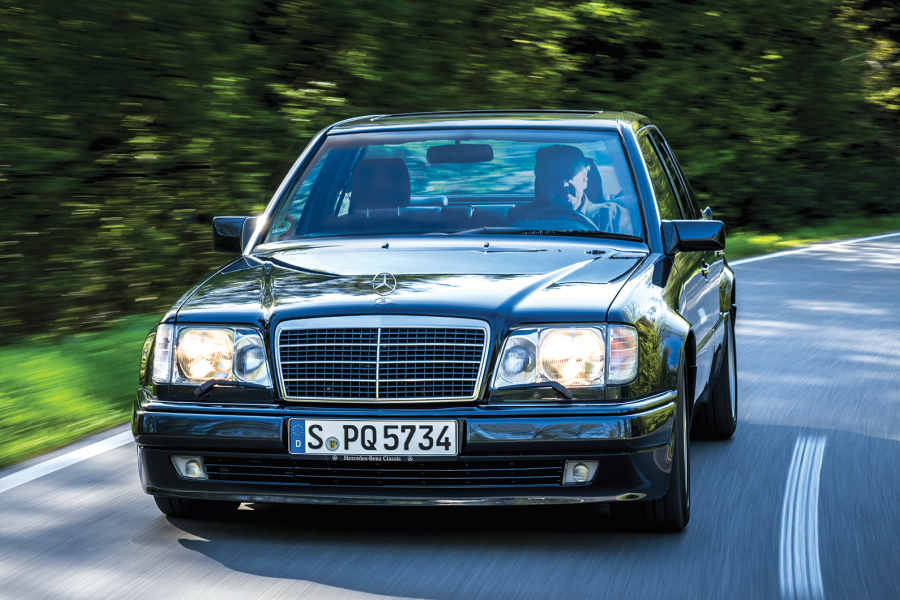The 125mph Benz is a solid 10mph faster than the Rolls-Royce outright, but more relevant is the ability to cruise at high speed; 100mph feels ideal in both but the Shadow is much quieter, a detached personal environment into which only road noise intrudes more than it should, probably because the car is generally so isolated from other sources of external din.
Like most ’60s Shadows this car has the four-speed Hydramatic ’box rather than the later three-speed GM400, which means a large gap between the 33mph second and 70mph third.
Driven discreetly changes are imperceptible, but more aggressive driving tends to highlight the gap.
Generally progress is serene and you can set up the car for corners by snicking down into third on the beautifully tactile electric column ‘wand’.
Our Buckley can’t choose between these two in terms of aesthetics
Observed from the tailing Mercedes, the handsome MPW doesn’t roll as much as you expect.
Blessed with superb brakes and straight-line stability that is the equal of the German car (which tends to nosedive under hard braking), the Royce is not a car that is naturally disposed to being handled roughly but has greater built-in margins than its initial responses suggest.
Certainly, compared to the nicely weighted Benz, its steering takes some getting used to.
The sweeping, elegant lines of this W111 coupé
Very light and utterly bereft of feel, it does disservice to the essentially sound handling.
But once you have learned not to over-correct – and over-think – the way you guide this gentle car, the going becomes more fluid and you can push on quite effectively, although the wide, slippery seats mean that anything beyond mildly brisk cornering tends to alarm passengers.
Town manners are beyond reproach, so you begin to understand why the steering is the way it is, giving the early Shadows a wieldy effortlessness that makes them relaxing in all situations.
Three-pointed star versus the Spirit of Ecstacy
The Mercedes is no sports car, but it feels like one after the Shadow. It rolls and understeers a lot less, and you can place it to the inch rather than the nearest 6in.
Its tamed low-pivot swing axles really date it as a design with its origins in the ’50s, but in this final development they generate quite a lot of grip.
If the Rolls-Royce filters out the messages it feels you don’t need to know, the Benz involves you in the decision-making: it seems natural to use the acceleration because it feeds back in a more accurate register.
At the same time it almost matches the superb ride of the Shadow; both cars steamroller road imperfections into submission, but there is a supreme sense of weight and substance under delicate control in the way the Rolls gently plunges then levels itself over undulations.
‘If the Rolls-Royce filters out the messages it feels you don’t need to know, the Benz involves you in the decision-making’
If you have your sights set on a Mercedes-Benz 280SE 3.5 Coupé there is probably nothing I can say in favour of the two-door Shadow that would sway your decision, least of all the fact that (in this case at least) you could have two coachbuilt Rolls-Royces for the price of the one Benz.
You can, of course, find much better value in the realm of the 3.5-litre W108 saloons, which drive identically and are very handsome in their own right.
And while every chin-stroking, polo-neck-wearing London design guru has fantasised over these superb coupés since at least the mid-’80s, you can see how that argument would not cut much ice here, either: such people do not see themselves in Rolls-Royces.
With extra chrome and fussier styling, the Benz feels a touch more ostentatious, yet remains an attractive and well-balanced design
Maybe it’s a form of cultural self-loathing – the ‘if it’s British it must be rubbish’ mindset – but put the sociological baggage to one side and these cars, directly descended from six-figure, blue-chip greats, are undervalued machines with a unique flavour of refinement and engineering excellence for which there is no real substitute if you value those qualities.
I am very clear on which one I prefer and which one I would buy, even if money was not an issue.
Images: Olgun Kordal
Thanks to Classic Automobiles Worldwide
Factfiles
Rolls-Royce Silver Shadow Mulliner Park Ward
- Sold/number built 1966-’71/568
- Construction steel monocoque, with aluminium doors, bonnet and bootlid
- Engine all-alloy, ohv 6250cc V8, twin SU carburettors
- Max power not disclosed
- Max torque not disclosed
- Transmission four-speed automatic, RWD
- Suspension independent, at front by double wishbones, anti-roll bar rear semi-trailing arms; coil springs, self-levelling f/r
- Steering power-assisted recirculating ball
- Brakes powered discs
- Length 16ft 11½in (5169mm)
- Width 6ft (1829mm)
- Height 4ft 10¾in (1492mm)
- Wheelbase 9ft 11½in (3035mm)
- Weight 4816Ib (2185kg)
- 0-60mph 10.8 secs
- Top speed 116mph
- Mpg 10-13
- Price new £11,556
- Price now £60,000*
Mercedes-Benz 280SE 3.5 Coupé
- Sold/number built 1969-’71/3720
- Construction steel monocoque
- Engine iron-block, alloy-heads, sohc-per-bank 3499cc V8, Bosch fuel injection
- Max power 200bhp @ 6500rpm
- Max torque 231Ib ft @ 4200rpm
- Transmission four-speed automatic, RWD
- Suspension independent, at front by double wishbones, anti-roll bar rear low-pivot swing axles, trailing arms; coils, telescopic dampers f/r
- Steering power-assisted recirculating ball
- Brakes discs, with servo
- Length 16ft ¼in (4883mm)
- Width 6ft ½in (1842mm)
- Height 4ft 8½in (1435mm)
- Wheelbase 9ft ¼in (2750mm)
- Weight 3460Ib (1569kg)
- 0-60mph 9 secs
- Top speed 125mph
- Mpg 15-20
- Price new £6700
- Price now £120,000*
*Prices correct at date of original publication
READ MORE
Dream drop-tops: Aston vs Mercedes vs Citroën vs Jensen vs Rolls
Grand Palais: the DS coupé Citroën should have made
Coupé conundrum: Ford Capri vs Datsun 240Z
Martin Buckley
Senior Contributor, Classic & Sports Car




































